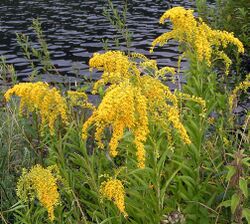Biology:Solidago gigantea
| Solidago gigantea | |
|---|---|

| |
| Scientific classification | |
| Kingdom: | Plantae |
| Clade: | Tracheophytes |
| Clade: | Angiosperms |
| Clade: | Eudicots |
| Clade: | Asterids |
| Order: | Asterales |
| Family: | Asteraceae |
| Genus: | Solidago |
| Species: | S. gigantea
|
| Binomial name | |
| Solidago gigantea Aiton
| |
| Synonyms[1] | |
|
Synonymy
| |
Solidago gigantea is a North American plant species in the family Asteraceae.[2]:211 Its common names include tall goldenrod[3] and giant goldenrod,[4] among others.
Goldenrod is the state flower of Kentucky,[5] and Solidago gigantea is the state flower of Nebraska.[6]
Description
Solidago gigantea is a perennial herb that reaches heights of up to 2 m (6.6 ft) tall, sometimes spreading by means of underground rhizomes. It often grows in clumps with no leaves at the base but numerous leaves on the stem. At the top, each stem produces a sizable array of many small flower heads, sometimes several hundred. Each head is yellow, containing both disc florets and ray florets.[3]
Habitat
Solidago gigantea is found in a wide variety of natural habitats, although it is restricted to areas with at least seasonally moist soils.[3][7]
Distribution
It is a widespread species known from most of non-arctic North America east of the Rocky Mountains. It has been reported from every state and province from Alberta to Nova Scotia to Florida to Texas , and also from the state of Nuevo León in northeastern Mexico.[8][9]
Environmental impact
Solidago gigantea is highly invasive throughout Europe and Asia.[10] In its non-native range, it exerts a negative impact on native communities by decreasing species richness and diversity, apparently due to its intense competitive effects,[11] rapid growth,[12] or polyploidization.[13] In the non-native European range, several management options are applied, such as periodical flooding, mowing, mulching, grazing, or herbicide to reduce the negative impact of the species on native biodiversity.[14]
Diseases
Parasitized by the Basidiomycete Coleosporium asterum.[15]
Galls
This species is host to the following insect induced galls:
- Asphondylia rosulata Dorchin, 2015 (leaf snap)
- Asphondylia solidaginis Beutenmuller, 1907 (leaf snap)
- Asteromyia carbonifera (Osten Sacken, 1862)
- Dasineura folliculi (Felt, 1908)
- Epiblema scudderiana (Clemens, 1860)
- Eurosta solidaginis (Fitch, 1855)
- Gnorimoschema gallaesolidaginis (Fitch, 1855)
- Gnorimoschema jocelynae Miller, 2000
- Rhopalomyia capitata Felt, 1908 (spring and generations)
- Rhopalomyia inquisitor Felt, 1908
- Schizomyia racemicola (Osten Sacken, 1862)
- Tephritis pura (Loew, 1873)
References
- ↑ "Solidago gigantea Aiton". Kew, London: Royal Botanic Gardens, Kew. 2019. http://powo.science.kew.org/taxon/urn:lsid:ipni.org:names:249575-1/.
- ↑ (in la) Hortus Kewensis; or, a catalogue of the plants cultivated in the Royal Botanic Garden at Kew. 3. London: George Nicol. 1789. https://www.biodiversitylibrary.org/page/5874758/. Retrieved 6 February 2021.
- ↑ 3.0 3.1 3.2 Flora of North America Editorial Committee, ed. (2006), "Solidago gigantea", Flora of North America North of Mexico (FNA), 20, New York and Oxford, http://www.efloras.org/florataxon.aspx?flora_id=1&taxon_id=242417286, retrieved 8 November 2014
- ↑ "Solidago gigantea". Natural Resources Conservation Service PLANTS Database. USDA. https://plants.usda.gov/core/profile?symbol=SOGI.
- ↑ Kentucky State Legislature. "Kentucky Revised Statutes: TITLE I SOVEREIGNTY AND JURISDICTION OF THE COMMONWEALTH - CHAPTER 2 CITIZENSHIP, EMBLEMS, HOLIDAYS, AND TIME - 2.090 State flower (PDF)". https://apps.legislature.ky.gov/law/statutes/statute.aspx?id=26. "2.090 State flower. The goldenrod is the official state flower of Kentucky. Effective: October 1, 1942. History: Recodified 1942 Ky. Acts ch. 208, sec. 1, effective October 1, 1942, from Ky. Stat. sec. 4618o."
- ↑ "Nebraska State Symbols". http://nebraskaccess.nebraska.gov/statesymbols.asp.
- ↑ Hilty, John (2016). "Giant Goldenrod - Solidago gigantea". http://www.illinoiswildflowers.info/wetland/plants/gt_goldenrod.htm.
- ↑ "Solidago gigantea", County-level distribution map from the North American Plant Atlas (NAPA) (Biota of North America Program (BONAP)), 2014, http://bonap.net/MapGallery/County/Solidago%20gigantea.png, retrieved 15 June 2015
- ↑ "Photo of herbarium specimen collected in Nuevo León, Mexico". http://www.tropicos.org/Image/100014590.
- ↑ Weber, E.; Jakobs, G. (2 May 2005). "Biological flora of central Europe: Solidago gigantea Aiton". Flora - Morphology, Distribution, Functional Ecology of Plants (Amsterdam: Elsevier) 200 (2): 109–118. doi:10.1016/j.flora.2004.09.001. ISSN 0367-2530. https://www.sciencedirect.com/science/article/abs/pii/S0367253005000113. Retrieved 14 May 2020.
- ↑ Pal, R.W.; Chen, S.; Nagy, D.U.; Callaway, R.M. (2015). "Impacts of Solidago gigantea on other species at home and away". Biological Invasions (New York: Springer) 17 (11): 3317–3325. doi:10.1007/s10530-015-0955-7. https://link.springer.com/article/10.1007/s10530-015-0955-7. Retrieved 14 May 2020.
- ↑ Jakobs, G.; Weber, E.; Edwards, P.J. (2004). "Introduced plants of the invasive Solidago gigantea (Asteraceae) are larger and grow denser than conspecifics in the native range". Diversity and Distributions (Diversity and Distribution) 10: 11–19. doi:10.1111/j.1472-4642.2004.00052.x.
- ↑ Nagy, D.U.; Stranczinger, S.; Godi, A.; Weisz, A.; Rosche, C.; Suda, J.; Mariano, M.; Pal, R.W. (April 2018). "Does higher ploidy level increase the risk of invasion? A case study with two geo-cytotypes of Solidago gigantea Aiton (Asteraceae)". Journal of Plant Ecology 11 (2): 317–327. doi:10.1093/jpe/rtx005. https://academic.oup.com/jpe/article/11/2/317/2964627. Retrieved 14 May 2020.
- ↑ Nagy, D.U.; Rauschert, E.S.J.; Henn, T.; Cianfaglione, K.; Stranczinger, S.; Pal, R.W. (June 2020). "The more we do, the less we gain? Balancing effort and efficacy in managing the Solidago gigantea invasion". Weed Research (Oxford, UK: John Wiley & Sons Ltd) 60 (3): 232–240. doi:10.1111/wre.12417. ISSN 1365-3180.
- ↑ McTaggart, Alistair R.; Aime, M. Catherine (2018). "The species of Coleosporium (Pucciniales) on Solidago in North America". Fungal Biology (British Mycological Society (Elsevier)) 122 (8): 800–809. doi:10.1016/j.funbio.2018.04.007. ISSN 1878-6146. PMID 30007430.
<ref> tag with name "NatServ" defined in <references> is not used in prior text.External links
Wikidata ☰ Q609627 entry
 |


